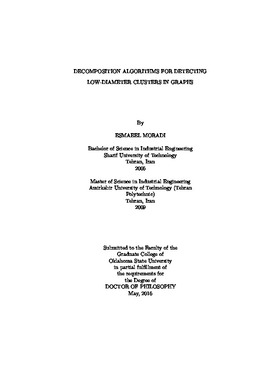| dc.contributor.advisor | Balasundaram, Balabhaskar | |
| dc.contributor.author | Moradi, Esmaeel | |
| dc.date.accessioned | 2017-02-22T22:10:13Z | |
| dc.date.available | 2017-02-22T22:10:13Z | |
| dc.date.issued | 2016-05 | |
| dc.identifier.uri | https://hdl.handle.net/11244/48850 | |
| dc.description.abstract | Detecting low-diameter clusters in graphs is an effective graph-based data mining technique, which has been used to find cohesive subgraphs in a variety of graph models of data. Low pairwise distances within a cluster can facilitate fast communication or good reachability between vertices in the cluster. A k-club is a subset of vertices, which induces a subgraph of diameter at most k. For low values of the parameter k, this model offers a graph-theoretic relaxation of the clique model that formalizes the notion of a low-diameter cluster. The maximum k-club problem is to find a k-club with maximum cardinality in a given graph. The goals of this study are focused on developing decomposition and cutting plane methods for the maximum k-club problem for arbitrary k. | |
| dc.description.abstract | Two compact integer programming formulations for the maximum k-club problem were presented by other researchers. These formulations are very effective integer programming approaches presently available to solve the maximum k-club problem for any given value of k. Using model decomposition techniques, we demonstrate how the fundamental optimization problem of finding a maximum size k-club can be solved optimally on large-scale benchmark instances. Our approach circumvents the use of complicated formulations in favor of a simple relaxation based on necessary conditions, combined with canonical hypercube cuts introduced by Balas and Jeroslow. Next, we demonstrate that by using a delayed constraint generation approach in a branch-and-cut algorithm, we can significantly speed-up the performance of an integer programming solver over the direct solution of the implementation of either formulation. | |
| dc.description.abstract | Then, we study the problem of detecting large risk-averse 2-clubs in graphs subject to probabilistic edge failures. To achieve risk aversion, we first model the loss in 2-club property due to probabilistic edge failures as a function of the decision (chosen 2-club cluster) and randomness (graph structure). Then, we utilize the conditional value-at-risk of the loss for a given decision as a quantitative measure of risk, which is bounded in the stochastic optimization model. A sequential cutting plane method that solves a series of mixed integer linear programs is developed for solving this problem. | |
| dc.format | application/pdf | |
| dc.language | en_US | |
| dc.rights | Copyright is held by the author who has granted the Oklahoma State University Library the non-exclusive right to share this material in its institutional repository. Contact Digital Library Services at lib-dls@okstate.edu or 405-744-9161 for the permission policy on the use, reproduction or distribution of this material. | |
| dc.title | Decomposition algorithms for detecting low-diameter clusters in graphs | |
| dc.contributor.committeeMember | Kamath, Manjunath | |
| dc.contributor.committeeMember | Zhao, Chaoyue Charlene | |
| dc.contributor.committeeMember | Sharda, Ramesh | |
| osu.filename | Moradi_okstate_0664D_14679.pdf | |
| osu.accesstype | Open Access | |
| dc.type.genre | Dissertation | |
| dc.type.material | Text | |
| thesis.degree.discipline | Industrial Engineering and Management | |
| thesis.degree.grantor | Oklahoma State University | |
